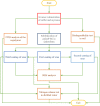Synthesis and performance evaluation of slow-release fertilizers produced from inverse vulcanized copolymers obtained from industrial waste
- PMID: 36909756
- PMCID: PMC9996625
- DOI: 10.1039/d3ra00256j
Synthesis and performance evaluation of slow-release fertilizers produced from inverse vulcanized copolymers obtained from industrial waste
Abstract
To improve crop nutrient uptake efficacy (NUE) and better manage fertilization, slow-release fertilizers (SRFs) are developed by either coating the urea granules or making a composite. Several materials have already been developed, nevertheless, scalability of those materials is still a challenge due to their inherit drawbacks (such as hydrophilicity, crystallinity, non-biodegradability, etc.). Herein, we utilized a biodegradable, green and sustainable copolymer produced from industrial waste (sulfur-petroleum industry waste and myrcene-citrus industry waste) to coat the urea using a facile coating method to develop novel SRFs and achieve better agronomic and environmental advantages. The copolymer was first synthesized using a facile, solvent-free one-pot method called inverse vulcanization followed by Fourier transform infrared spectroscopy (FTIR) analysis to confirm the successful reaction between myrcene and sulfur subsequently coating the copolymer on urea granule. The morphology and coating thickness of coated fertilizers were analysed using scanning electron microscopy (SEM), followed by a nitrogen release test in distilled water and a soil burial test to confirm the biodegradability. The nitrogen release test revealed that the SRF with the maximum coating thickness of 1733 μm releases only 16% of its total nitrogen after 4 days of incubation compared to the pristine urea which releases all its nutrient within 1 day. The soil burial test confirms the biodegradability of the copolymer, as after 50 days of incubation in soil the copolymer loses almost 18.25% of its total weight indicating that the copolymer is degrading.
This journal is © The Royal Society of Chemistry.
Conflict of interest statement
The authors declare that they have no conflict of interest.
Figures








References
-
- Karnakar R. R. Shankapal P. P. Suryawanshi R. D. Gite V. V. Coating of urea granules with epoxidized vegetable oil cured by triethylenetetramine for control release: A green approach. Mater. Today Proc. 2022;60:1165–1171. doi: 10.1016/j.matpr.2022.03.212. - DOI
-
- Zhang S. Yang M. Meng S. Yang Y. Li Y. C. Tong Z. Biowaste-derived, nanohybrid-reinforced double-function slow-release fertilizer with metal-adsorptive function. Chem. Eng. J. 2022;450 doi: 10.1016/j.cej.2022.138084. - DOI
-
- Nguyen G. N., Joshi S. and Kant S., Nitrogen Use in Plants, Elsevier Inc., 2017
LinkOut - more resources
Full Text Sources
Miscellaneous

